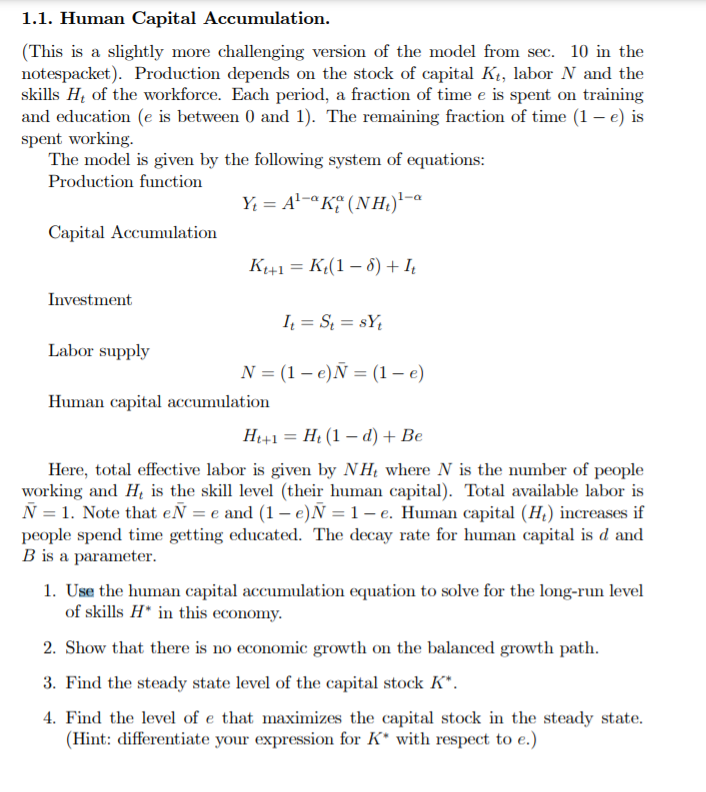
1.1. Human Capital Accumulation. (This is a slightly more challenging version of the model from sec. 10 in the notespacket). Production depends on the stock of capital Kt, labor N and the skills H of the workforce. Each period, a fraction of time e is spent on training and education (e is between 0 and 1). The remaining fraction of time (1 - e) is spent working The model is given by the following system of equations: Production function Y = Al-K, (NH)-- Capital Accumulation Kt+1 = K (1-5)+14 Investment 14 = S = sy Labor supply N = (1 - e) N = (1-e) Human capital accumulation Ht+1 = H (1 - d) + Be Here, total effective labor is given by NH, where N is the number of people working and He is the skill level (their human capital). Total available labor is = 1. Note that e = e and (1 e) = 1- e. Human capital (H) increases if people spend time getting educated. The decay rate for human capital is d and B is a parameter. 1. Use the human capital accumulation equation to solve for the long-run level of skills H* in this economy. 2. Show that there is no economic growth on the balanced growth path. 3. Find the steady state level of the capital stock K*. 4. Find the level of e that maximizes the capital stock in the steady state. (Hint: differentiate your expression for K* with respect to e.) 1.1. Human Capital Accumulation. (This is a slightly more challenging version of the model from sec. 10 in the notespacket). Production depends on the stock of capital Kt, labor N and the skills H of the workforce. Each period, a fraction of time e is spent on training and education (e is between 0 and 1). The remaining fraction of time (1 - e) is spent working The model is given by the following system of equations: Production function Y = Al-K, (NH)-- Capital Accumulation Kt+1 = K (1-5)+14 Investment 14 = S = sy Labor supply N = (1 - e) N = (1-e) Human capital accumulation Ht+1 = H (1 - d) + Be Here, total effective labor is given by NH, where N is the number of people working and He is the skill level (their human capital). Total available labor is = 1. Note that e = e and (1 e) = 1- e. Human capital (H) increases if people spend time getting educated. The decay rate for human capital is d and B is a parameter. 1. Use the human capital accumulation equation to solve for the long-run level of skills H* in this economy. 2. Show that there is no economic growth on the balanced growth path. 3. Find the steady state level of the capital stock K*. 4. Find the level of e that maximizes the capital stock in the steady state. (Hint: differentiate your expression for K* with respect to e.)







